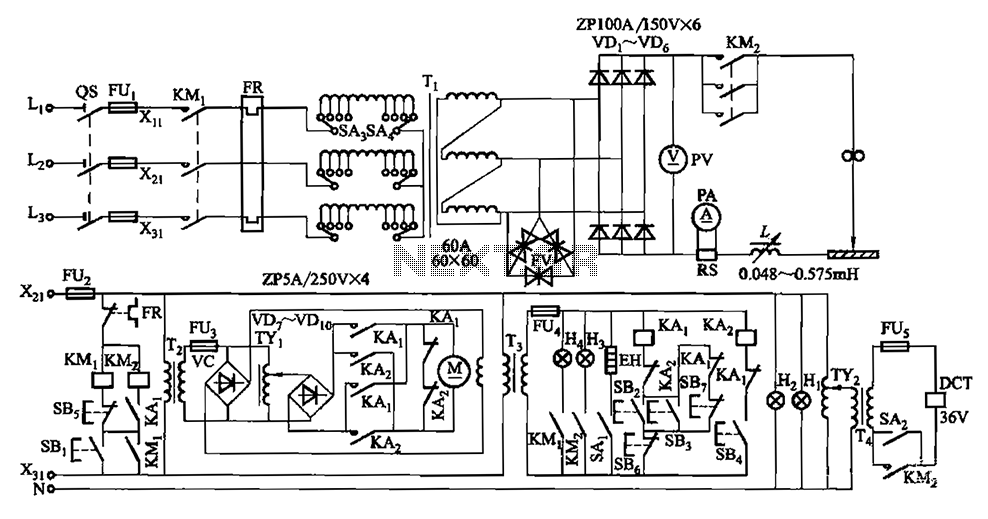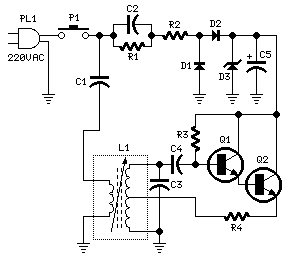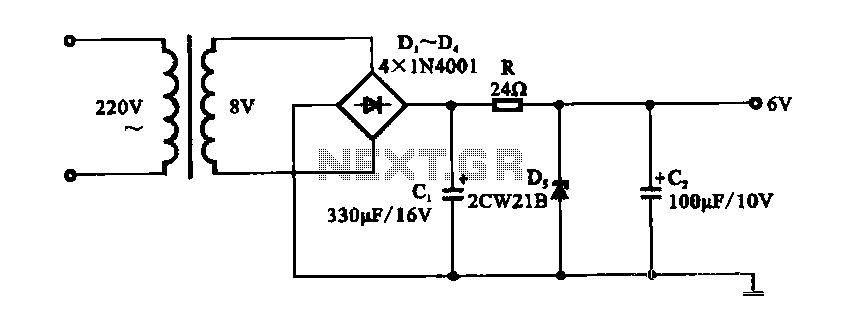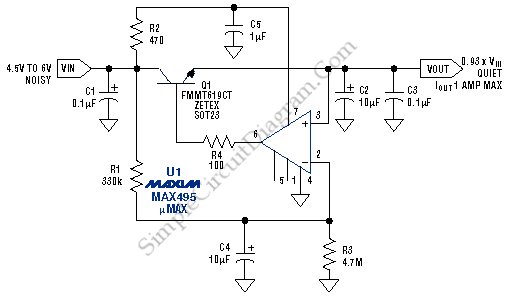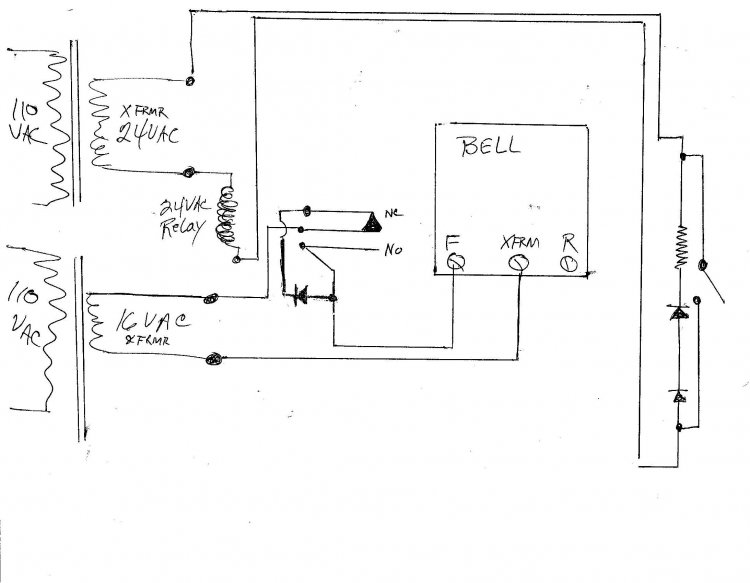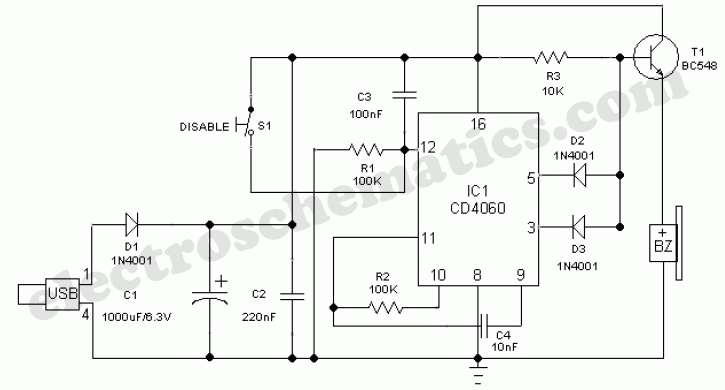
IN148 diode temperature measurement circuit
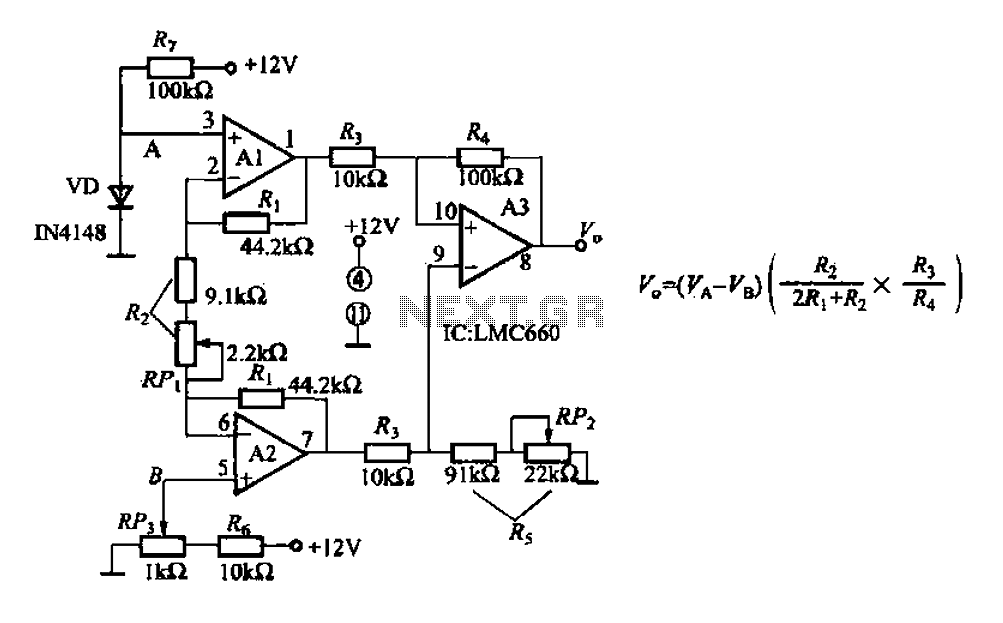
A diode IN4148 temperature circuit is presented. The circuit operates within a temperature range of -25 to 125 degrees Celsius, with an accuracy of 0.5. The core components of the operational amplifier circuit consist of four LMC660 amplifiers. It features a voltage gain of 126 dB, an input voltage drift of 3 mV, a temperature drift of 1.3 µV/°C, and an input bias current as low as 2 pA. The distortion is measured at 0.01% (at 10 kHz), with a conversion rate of 1.1 V/µs. The circuit operates in single supply mode with a voltage range of +5 to +15 V. Three of the operational amplifiers (A1) form a differential instrumentation amplifier (A3), where A1 and A2 serve as the inverting inputs. The inputs of A3 are symmetrical. When R4 equals R5, the output voltage is determined by the formula vo = (VA - VB) * R1R3 / [R4 * (2R1 + R2)], where VA and VB are the potentials at points A and B, respectively. The change in the output signal from point A is influenced by the set-point potential at point B. As the potentials at point A and VB vary with temperature, the output voltage vo is amplified accordingly. RP3 is used for zero adjustment, ensuring that the output voltage is calibrated to 0.0 mV. RPi is for gain trimming, while RP2 is for adjusting the common-mode rejection ratio (CMRR).
The IN4148 diode temperature circuit is designed to measure temperature variations with high precision and accuracy. The operational amplifier configuration, particularly the use of the LMC660 components, allows for significant amplification of small voltage changes, making it suitable for applications requiring sensitive temperature measurements. The specified temperature range of -25 to 125 °C ensures versatility in various environmental conditions, while the accuracy of 0.5 °C enhances the reliability of readings.
The differential instrumentation amplifier configuration is crucial for rejecting common-mode signals, which could introduce noise and inaccuracies in the temperature readings. By employing three operational amplifiers, the circuit achieves a high input impedance and a low output impedance, facilitating better signal integrity and minimizing the loading effect on the sensor.
The adjustable resistors RP1, RP2, and RP3 provide flexibility in fine-tuning the circuit's performance. RP1 allows for precise gain adjustments, ensuring that the output voltage corresponds accurately to the input signal. RP2's role in CMRR adjustment is vital for maintaining the circuit's performance in noisy environments, while RP3 enables zero offset calibration, which is essential for accurate temperature readings from the sensor.
Overall, this diode IN4148 temperature circuit exemplifies a well-engineered solution for precise temperature measurement, leveraging advanced operational amplifier technology to achieve high performance in a compact design.A diode IN4148 temperature circuit is shown. The circuit temperature range - 25-125, accuracy of soil 0.5. Core elements of the operational amplifier circuit is four LMC660, it s voltage gain of 126dB, the input voltage drift 3mV, temperature drift 1.3hcV/C, input bias current as low as 2pA, distortion of 0.Ol% (lOkHz), the conversion rate of 1. IV/hLS, working in single supply mode, a voltage range of +5 + 15V. LMC660 three of the operational amplifier Al constitute a differential instrumentation amplifier A3, Al and A2 inverting input of the inverting input, A3 inputs are symmetrical, when R4 Rs, the output voltage is determined by vo ( VA - VB) 1R2R3/[R4 (2Ri + R2)]} where, V, as a, B two points of potential, once the set-point potential B, the amount of change of the output signal from the a, respectively, on the decision point potential a.
Due to the potential of the point A and VD varies with temperature, after which the amplified output voltage variation vo. RP3 for adjusting the zero, 0, the tone RP3, so that the output voltage is 0.OmV. RPi trim gain, RP2 trim CMRR.
The IN4148 diode temperature circuit is designed to measure temperature variations with high precision and accuracy. The operational amplifier configuration, particularly the use of the LMC660 components, allows for significant amplification of small voltage changes, making it suitable for applications requiring sensitive temperature measurements. The specified temperature range of -25 to 125 °C ensures versatility in various environmental conditions, while the accuracy of 0.5 °C enhances the reliability of readings.
The differential instrumentation amplifier configuration is crucial for rejecting common-mode signals, which could introduce noise and inaccuracies in the temperature readings. By employing three operational amplifiers, the circuit achieves a high input impedance and a low output impedance, facilitating better signal integrity and minimizing the loading effect on the sensor.
The adjustable resistors RP1, RP2, and RP3 provide flexibility in fine-tuning the circuit's performance. RP1 allows for precise gain adjustments, ensuring that the output voltage corresponds accurately to the input signal. RP2's role in CMRR adjustment is vital for maintaining the circuit's performance in noisy environments, while RP3 enables zero offset calibration, which is essential for accurate temperature readings from the sensor.
Overall, this diode IN4148 temperature circuit exemplifies a well-engineered solution for precise temperature measurement, leveraging advanced operational amplifier technology to achieve high performance in a compact design.A diode IN4148 temperature circuit is shown. The circuit temperature range - 25-125, accuracy of soil 0.5. Core elements of the operational amplifier circuit is four LMC660, it s voltage gain of 126dB, the input voltage drift 3mV, temperature drift 1.3hcV/C, input bias current as low as 2pA, distortion of 0.Ol% (lOkHz), the conversion rate of 1. IV/hLS, working in single supply mode, a voltage range of +5 + 15V. LMC660 three of the operational amplifier Al constitute a differential instrumentation amplifier A3, Al and A2 inverting input of the inverting input, A3 inputs are symmetrical, when R4 Rs, the output voltage is determined by vo ( VA - VB) 1R2R3/[R4 (2Ri + R2)]} where, V, as a, B two points of potential, once the set-point potential B, the amount of change of the output signal from the a, respectively, on the decision point potential a.
Due to the potential of the point A and VD varies with temperature, after which the amplified output voltage variation vo. RP3 for adjusting the zero, 0, the tone RP3, so that the output voltage is 0.OmV. RPi trim gain, RP2 trim CMRR.
